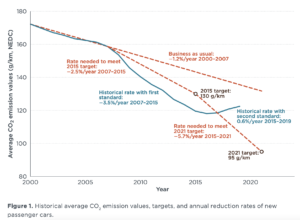Overview
The European Union (EU) implemented mandatory fleet-wide average carbon dioxide standards in 2009 and updated them in 2019. The current standards, introduced under Regulation (EC) 443/2009, established a goal of 95 grams carbon dioxide/km, measured in NEDC, by 2021. In 2018, representatives of the European Commission, the European Parliament, and the European Council agreed on a compromise for the EU regulation setting binding carbon dioxide (CO2) emission targets for new passenger cars and light commercial vehicles for 2025 and 2030 under (EU) 2019/631.
Standard type
CO2 emission limits
Regulating Body
European Union (European Commission, Parliament, Council, and Member States)
Current Standard
95 gCO2/km by 2021 Regulation (EU) 2019/631
Applicability
New passenger vehicles and light commercial vehicles
History
With an output of over 17 million vehicles per year, the 28-member European Union (EU) is the world’s second-largest producer of automobiles. Every fourth vehicle sold globally is produced in or imported into Europe, and many countries around the world follow the EU’s emission standards roadmap. As a result, the European market and EU emission regulations influence the business decisions of major vehicle manufacturers around the world.
Passenger vehicles generate 12 percent of all CO2 emissions in the EU, and emissions from transport increased by 26 percent between 1990 and 2010. Recognizing the large and growing impact of these vehicles on climate change, the EU began programs to reduce fleet average CO2 emissions. Initially, voluntary targets were established for manufacturers in the mid-1990s. The EU ultimately shifted from voluntary to mandatory standards in 2009, implementing legislation to cap vehicle CO2 emissions. The regulations only cover CO2 emissions; other greenhouse gases are not regulated. Brief overviews of the voluntary and mandatory programs are as follows:
| Year | Vehicle type | Targets | Additional details |
|---|---|---|---|
| 1995 | Passenger vehicle (PV) | The European Commission (EC) adopted a strategy for reducing CO2 emissions from passenger vehicles that relied on voluntary commitments from the auto industry, improvements in consumer information, and the promotion of fuel-efficient cars through fiscal measures. | |
| 1998 | PV | Voluntary target of 140 gCO2/km established for new vehicles by 2008 for the European Car Manufacturers Association and by 2009 for the Japan Automobile Manufacturers Association and the Korean Automobile Manufacturers Association. | Only two manufacturers met these voluntary targets. |
| 2009 | PV | 130 gCO2/km by 2015; 95 gCO2/km by 2020 | Emissions measured over the NEDC test cycle. Super-credits for vehicles emitting less than 50 gCO2/km. |
| 2011 | Light-commercial vehicle (LCV) | 175 gCO2/km by 2017; 147 gCO2/km by 2020 | Super-credits for vehicles emitting less than 50 gCO2/km. |
| 2013 | Two- and three-wheelers | Manufacturers are required to calculate and report CO2 emissions | |
| 2014 | PV and LCV |
PV: 95 gCO2/km for 95% of vehicles by 2020, all vehicles by 2021 LCV: 147 gCO2/km by 2020 |
|
| 2019 | PV and LCV |
PV: 15% reduction from 2021 levels by 2025 and 37.5% reduction from 2021 levels by 2030 LCV: 15% reduction from 2021 levels by 2025 and 31% reduction from 2021 levels by 2030 |
In 2020, the ICCT assessed how manufacturers performed relative to the standards. The graph below shows the performance of top-selling EU passenger car manufacturer groups for 2019, relative to the 2015 and 2021 standards.
Technical Standards
2014: 95 g/km PV standard, 147 g/km LCV standard by 2020
In 2014, the European Parliament and the Council of the European Union adopted amendments to the 2009 and 2011 standards, implementing mandatory 2020 CO2 emission targets for new passenger cars and light commercial vehicles in the European Union.
In 2019, a new regulation setting CO2 targets from 2021 onwards for both passenger cars and light commercial vehicles was adopted, repealing the former standards from 2009 and 2011, respectively. A target value of 95 g/km of CO2 for 2020 for the new car fleet was set; however, there was a one-year phase-in period, requiring 95 percent of new car sales to comply with the target in 2020 and 100 percent from 2021 onwards. In terms of fuel consumption, the 2020 target equates to approximately 4.1 L/100 km of petrol or 3.6 L/100 km of diesel. Vehicle weight is retained as the underlying utility parameter (i.e., the heavier a manufacturer’s car fleet, the higher the CO2 emission value allowed by the regulation). The factor to be used between 2020 and 2024 was set to 0.0333, meaning that for every 100 kg of additional vehicle weight, the emission of 3.33 g/km of additional CO2 is allowed.
For 2020, a target value of 147 g/km of CO2 for LCVs was set. Vehicle weight is retained as the underlying parameter, with a slope factor of 0.0960, meaning that for every 100 kg of additional vehicle weight, the emission of 9.60 g/km of additional CO2 is allowed.
From 2020 to 2022, there is a super-credits system for passenger cars that emit less than 50 gCO2/km on the NEDC. This system allows manufacturers to count these zero- and low-emission vehicles (ZLEVs) multiple times in calculating their average fleet emissions. In 2020, each ZLEV counts twice; in 2021, each ZLEV counts 1.67 times; in 2022, each ZLEV counts 1.33 times. Each manufacturer is capped at 7.5 gCO2/km over the three years using the super-credits system.
2019: 15% reduction by 2025, 37.5% reduction for PVs, and 31% reduction for LCVs from 2021 levels
Starting in 2025, new passenger cars and light commercial vehicles must have a 15% fleet-wide reduction in CO2 emissions compared to a 2021 baseline. The targets are expressed as reductions from the 2021 baseline because the test cycle was changed from NEDC to WLTP starting in 2021. Once 2021 WLTP-based CO2 emissions measurements are available, a numerical standard can be set.
A new ZLEV credit system applies in 2025 for car and van manufacturers. Fleet-wide ZLEV adoption will be subject to the following benchmarks: 15% of new cars and vans should be ZLEVs starting in 2025, where a ZLEV is defined as emitting less than 50 gCO2/km based on the WLTP. Exceeding these ZLEV benchmarks by one percent allows a manufacturer a one percent increase in their CO2 emission standard up to 5%. Additionally, the calculation of a fleet’s share of ZLEVs depends on a ZLEV’s emissions, so lower-emitting ZLEVs will count more towards the fleet-wide emissions goal.
Starting in 2030, new passenger cars and light-commercial vehicles must have a 37.5% fleet-wide reduction in CO2 emissions compared to a 2021 baseline, and new light commercial vehicles must have a 31% reduction in CO2 emissions compared to a 2021 baseline.
2030 Climate Target Plan – Fit for 55% Proposal
On 14 July 2021, the European Commission published a series of legislative proposals setting climate neutrality goals in the EU by 2050, which includes an intermediate target of a 55% greenhouse gas emissions reduction by 2030, compared to a 1990 baseline. As a part of its “Fit for 55%” legislative proposals, the Commission suggested an amendment to the (EU) 2019/631 CO2 emission standards for passenger cars and vans, setting more ambitious fleet targets from 2030 and 2035. Compared to 2021, new cars registered from 2030 onwards shall have on average 55 % lower and vans 50% lower CO2 emissions. From 2035 onwards, the Commission suggests a reduction target of -100 % CO2 for both cars and vans;, that is, only zero-emission vehicles can be registered from 2035 onwards. As with previous regulations, emission target stringency increases in 5-year intervals. Vehicle mass is continued to be used as a utility parameter when determining the manufacturer-specific CO2 targets, that is manufacturers of heavier vehicles get a higher CO2 target than those of lighter vehicles.
Testing Procedures
Previously, each manufacturer was required to test and report CO2 emission levels for every new model on the market using the NEDC. This was replaced by WLTP in 2017 for new cars and in 2018 for all cars. Starting in 2021, the WLTP was used to determine CO2 target compliance. Individual EU member states collect the data for all vehicles registered in their territory and report the information to the European Commission and the European Environment Agency.
Links
Regulatory Documents
- 2009 passenger vehicles, Regulation (EC) 443/2009
- 2011 light commercial vehicles, Regulation (EU) 510/2011
- 2013 two and three-wheeled vehicles, Regulation (EU) 168/2013
- 2014 passenger and light commercial vehicles, Regulation (EU) 333/2014 and Regulation (EU) 253/2014
- 2019 passenger vehicles, Regulation (EU) 2019/631
All CO2 emission regulation can be found on the EU climate action webpage.
Fit for 55, the EU’s plan for a green transition
ICCT Policy Update: EU CO2 standards for passenger cars and light-commercial vehicles, January 2014
ICCT Policy Update on original 2025 and 2030 standards
ICCT Briefing on 2019 performance of EU vehicles
ICCT Briefing on 2017 performance of EU vehicles



